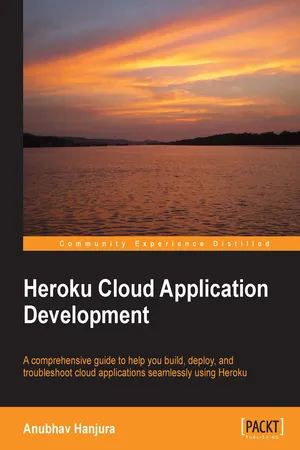
- 336 pages
- English
- ePUB (mobile friendly)
- Available on iOS & Android
Heroku Cloud Application Development
About This Book
In Detail
Heroku is one of the leading cloud platform-as-a-service technologies that aims to help you deploy feature-rich web apps with Elan. It supports several widely popular programming languages like Ruby, Java, PHP, and Python to name a few, and also offers support for multiple data sources (sqllite and postgres). Heroku is all about ease of deployment and application management, as it lets you build and run web apps without having to worry about the servers.
This book is about Heroku but more importantly, it is about the ease with which a developer with limited availability or knowledge of deployment infrastructure can run and manage a cloud app 24/7/365. It will show how Heroku is language independent and does not lock the user to a particular operating environment, giving users the flexibility of choosing the right software infrastructure based on the scale of the app hosted.
This books starts by unraveling the basics of the Heroku stack. The book then moves on to teach you simple steps to build and deploy an app on Heroku. You will also experience the ease of running and troubleshooting a Heroku app.
The book illustrates the process of creating a new web application with Heroku. Along the way, you will also learn some advanced topics such as configuring Heroku with web sockets, monitoring your apps, and managing your DNS for Heroku. The book will also detail the process of building custom build packs to support for other languages, how to enable Heroku for mobile apps and much more. This book will demonstrate the security processes in Heroku, enabling you to enforce tighter controls at every layer of the platform.
This book will help you build cloud applications the right awaythe first time and every timeas well as scale Heroku to achieve high availability and fine-tune the Heroku infrastructure.
Approach
An easy-to-follow, hands-on guide that clearly explains the various components of the Heroku platform and provides step-by-step guidance as well as numerous examples on how to build and troubleshoot robust and scalable production-ready web applications on the Heroku platform.
Who this book is for
This book is intended for those who want to learn Heroku the right way. Perhaps you are new to Heroku or are someone who has heard about Heroku but have not built anything significant with it. You should have knowledge or familiarity with cloud computing and basic knowledge of database and network deployment.
Frequently asked questions
Information
Heroku Cloud Application Development
Table of Contents
Table of contents
- Heroku Cloud Application Development